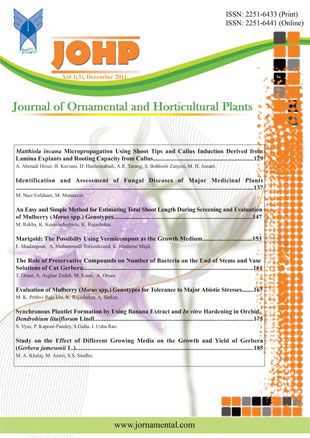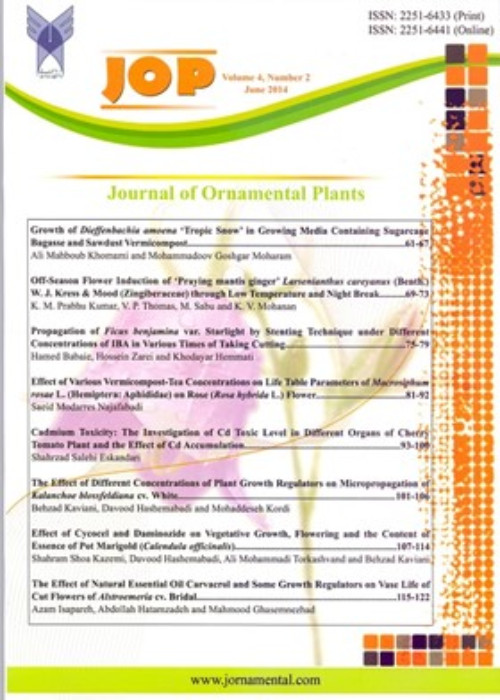فهرست مطالب

Journal of Ornamental Plants
Volume:3 Issue: 1, Winter 2013
- تاریخ انتشار: 1392/02/17
- تعداد عناوین: 8
-
Page 1Natural plant extracts / products have the potential as safe alternatives for chemical fungicides in plant disease management. Methanol and pure methanol:water (50:50 v/v) extracts of peppermint, lavandula, eucalyptus, datura and nettle were screened for their antifungal activity against Alternaria sesami, the causal agent of Alternaria leaf spot of sesame at 5, 10 and 15% concentrations in Shahrood Agricultural Research Center, Shahrood, Iran, during 2010. Poisoned food technique and spore germination assay were used to evaluate the antifungal potential of plant extracts against the pathogen.
Fungicide mancozeb 80WP (0.2%) was used for better comparison. Results indicated that methanolic extracts of peppermint (15 and 10%), lavandula (15%) and eucalyptus (15%) were more effective than methanol: water extracts and completely inhibited the growth of the pathogen. Among tested extracts, methanolic extracts of peppermint (15%) and eucalyptus (15%) were best in preventing the spore germination of the pathogen (P =0.01).Keywords: Alternaria sesami, Antifungal, Control, Plant extracts -
Page 9Dog rose (Rosa canina) has been using as a rootstock for ornamental roses also it is one of the medicinal plants. It can be propagated under in vitro conditions. After removing chilling requirement of buds, axillary wood buds of dog rose were cut in three nodal positions (lower, middle and terminal) on the stem and then explants after decontamination, cultured on Murashige and Skoog medium (MS medium) supplemented with 1 mg l-1 GA3 and 1 mg l-1 BAP. For shoot proliferation, MS medium supplemented with 1 mg l-1 GA3 and different concentration of PGRs. The results showed that maximum bud break percentage and highest shoot length were observed in lower nodal position. Minimum bud break percentage and shoot length were observed in middle nodal position. In the media with different concentrations of PGRs the highest shoot length was observed in combinations of BAP 1 mg l-1 and Ads 2 mg l-1. The large number of node and maximum axillary shoot percentage were observed in BAP 6 mg -1. The growth of dog rose was affected by different explants nodal position and growth regulators on in vitro. Assessment of BAP and Ads on axillary shoot percentage and node number was more effective than kinetin TDZ and BAP TDZ combination. In media with low concentration of BAP, TDZ and NAA and so kinetin, TDZ and NAA did not produce any axillary shoots or elongated shoots.Keywords: Dog rose, Growth regulators, In vitro, Nodal position, Proliferation
-
Page 19
The Asiatic hybrid lily, a bulbous ornamental plant, has a special position in the horticulture as cut flower. To overcome some problems in nutrition of bulb flowers, the use of hydroponic system and nutrient solution is important in the cultivation of these flowers. The Asiatic Hybrid Lilium bulbs Tresor cultivar, used for the current research were planted under 3 different calcium levels including 2, 4 and 6 mM as randomised completely designed with five replications. Comparing the mean values of the data showed that 6 mM calcium produced maximum height of the plant, stem diameter, procreative height, number of buds, flower diameter and longevity of cut flowers.
Keywords: Calcium, Plants nutrition, Soilless, Tresor lily -
Page 25An investigation was initiated to examine the effects of nanoscale titanium dioxide particles on plant growth and development. In view of the widespread cultivation of canola in Iran and in other parts of the globe and in view of the potential influence of titanium on its growth, this plant was chosen as the model system. Canola seeds were separately treated with different concentrations of nanoscale titanium dioxide (10, 100, 1000, 1200, 1500, 1700 and 2000 mg l-1 and the effect this treatment was studied on seed germination and seedling vigor. Treatment of nanoscale TiO2(20 nm mean particle size) at 2000 mg l-1 concentration promoted both seed germination and seedling vigor . The lowest and the highest germination rate were obtained in 1500 and 2000 mg l-1 treatments, respectively.
Higher concentrations of nanoscale TiO2 (1200 and 1500 mg l-1) showed large radicle and plumule growth of seedling compared to other concentrations and control. The inhibitory effect with lower nanoparticle concentration reveals the need for judicious usage of these particles in such applications. This is the first report on the effect of nanoscale particles on canola growth.Keywords: Canola, Nanoscale TiO2, Seedling growth, Seed germination, Seedling vigor -
Page 33In the present study, 2,4-dichlorophenoxyacetic acid (2,4-D) was assessed individually for its effectiveness to induce somatic embryogenesis in tea (Camellia sinenesis L.). Embryonic axes and cotyledons explants were dissected from the seeds. Explants were cultured on Murashige and Skoog (MS) medium containing 0, 1 and 5 μM 2,4-D alone for embryonic axes and 0, 1 and 5 μM 2,4-D along with 0 and 0.5 μM IBA for cotyledons. Embryos were observed in embryonic axes explants cultured on MS medium containing 1 μM 2,4-D. No somatic embryos were seen on cotyledons explants.Keywords: In vitro culture, 2, 4, D, Plant growth regulators, Medicinal plants, Micropropagation
-
Page 39(Gladiolus grandiflorus L.), a popular bulbous cut flower, has high demand in both domestic (Pakistani) as well as international markets. Five potential, exotic cultivars of gladiolus, Cantate, Corveira, Eminence, Essential and Fado were evaluated to determine the cultivar effects on yield and quality, to compare their relative performance and recommend their suitability for commercial production. Among the tested cultivars, Essential performed best for early spike emergence (74.2 d), greater number of leaves plant-1 (8.8), number of florets spike-1 (13.9), spike length (46.8 cm), spike diameter (1.0 cm), vase life (14.3 d), cormel diameter (0.7 cm) and average weight of a cormel (0.3 g). Corveira ranked second for most of the above mentioned growth and yield indices. Earlier sprouting (4.6 d), and higher number of cormels clump-1 (283.0) was recorded in Fado, while leaf area and stem length was greater in Cantate, (98.6 cm2 and 84.7 cm, respectively).
Eminence Cantate and Corveira had higher total leaf chlorophyll contents (0.2 mg g-1 each), while Eminence took longer time for spike emergence (103.5 d) among all tested cultivars. In summary, Essential followed by Corveira and Fado performed better than Eminence and Cantate. Therefore, growers may consider selection of these cultivars with improved yield and quality characteristics for commercial production.Keywords: Commercial production, Corm, Cultivar evaluation, Cut flower, Growth, Sword lily -
Page 49This Research aimed to study on effect of foliar spraying with zinc (as zinc sulphate), nitrogen (as urea) and iron (as sulphate and chelated Fe) on growth parameters, quality of fruit, flower characteristics, chemical constituents and nutrients content of leaves on grapevine. Applied nutrients were zinc sulphate (Zn) of 0.0 and 1.5gl-1 and urea (N) at 0.0 and 5 gl-1 and Fe (1) control (low Fe), (2) Fe (III)-chelate 3mgl-1, (3) 20 g/ per tree soil application and (4) Fe sulfate (FeSO4) 3mgl-1 which were applied both alone and in combinations with each other as foliar spraying. In a pot experiment, effects of N, Zn and Fe fertilizer were evaluated on concentrations of Fe, N and Zn in leaves, yield and the fruit quality of grape (Vitis viniferea). Results showed that application of urea and Zn and Fe increased vegetative growth and length of young branch.
Highest size of berry achieved in N2= 5 gl-1× Zn= 1.5 mg l-1 × Fe= chelates Fe 3 mg l-1. Nitrogen (N), iron (Fe) and zink (Zn) are essential element in grape vine causes increased contain N, Zn and Fe on leaves. Also results showed N Fe had significant difference (p ≤ 0.05) on quality and quantity(?) characters in grape vine, Zn and Fe have no significant difference (p ≤ 0.05).Keywords: Antifungal, Plant extracts, Control, Alternaria sesami -
Page 59A study was conducted to determine the optimum concentration of benzyladenie (BA) and gibberllic acid (GA3) to break the dormancy of gladiolus corms in relation to storage period and to find out the effect of BA and GA3 on growth and development of gladiolus corm and cormels. The effect of GA3 on dormancy breaking was most pronounced in the 100 ppm treatment being 26.93 days while in the water control took 49.60 days. Among different levels of BA, dormancy breaking was comparatively earlier by 29.60 days when treated with 50 BA. Considering storage periods, corms stored for 30 days followed by different growth regulator treatments sprouted 11.63 and 21.24 days earlier than 75 and 90 days stored corms, respectively. Corms treated with 75 ppm GA3 and stored for 90 days produced the maximum percentage of spikes (56.9%) whereas90 days stored corms treated with 125 ppm BA produced the highest number of plants (2.41) and corms (2.50) hill-1. The corms treated with 100 ppm GA3 and stored for 90 days produced the heaviest (21.50 g and 18.82 g, respectively) and largest (4.46 cm and 4.17 cm, respectively) corms.Keywords: Benzyl adenine, Gibberellic acid, Dormancy breaking, Gladiolus, Storage period


